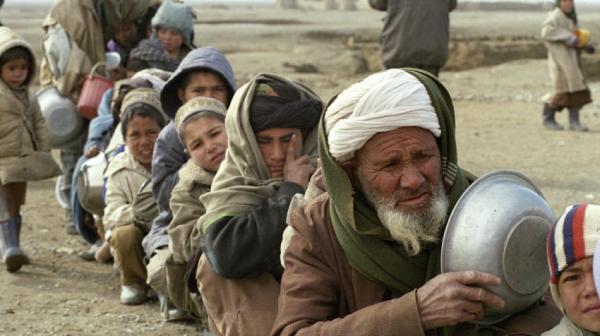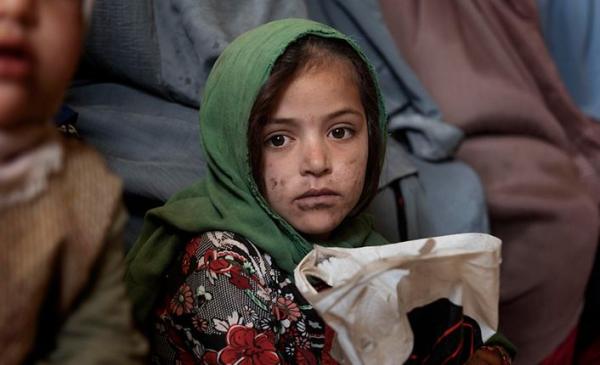
Starving people of all ages wait in food line because of famine in Afghanistan. Photo: UN
After 20 years of U.S. war to control Afghanistan, that country’s 40 million people are now in the grip of a devastating financial, economic and agricultural crisis which threatens the lives of millions. The U.S. is the main cause of this crisis—but not only is it barely lifting a finger to help, it is actively blocking others from helping, and is outright stealing billions of dollars from Afghanistan.
The New York Times, citing the UN emergency aid coordinator, reports that “a severe drought and the cumulative toll of decades of war have left more than half [of Afghanistan’s] population needing humanitarian aid and plunged three-quarters of its 40 million people into acute poverty…. Without international aid, a million Afghan children face acute hunger and another eight million people face ‘a march to starvation, and ultimately even possible famine.’” (See “Voices of Famine” sidebar.)
In addition, the health care system is in a state of near-collapse due to U.S. sanctions against the Taliban government, which for months cut off almost all humanitarian aid, even that which was administered directly by aid groups (rather than going through the Taliban government.)1
In the last few months, the U.S. has made a big show of slightly loosening these sanctions, but there is general agreement that it is too little, too late to have a major impact on the unfolding crisis. The Biden administration brags about contributing 474 million dollars in humanitarian aid in the last six months. This is a drop in the bucket—the UN is urgently trying to raise five billion dollars as a stopgap measure to avert disaster. It is worth noting that—according to Biden himself—the U.S. spent 300 million dollars a day trying to dominate Afghanistan. So the U.S. spent more in two days of waging war on Afghanistan than it has spent in six months “humanitarian aid”!

Young girl in Afghanistan waits for food. Photo: UNICEF
Causes of the Crisis
Many factors have converged to create this staggering human catastrophe, including the impact of the COVID pandemic, and increasingly severe drought afflicting the rural population—more than two-thirds of the population. These droughts are in turn worsened by climate change, which is mainly driven by the U.S. and other wealthy nations.
But the main factors are related to the U.S. invasion and occupation, and—after the U.S. suffered a humiliating defeat—its efforts to economically strangle the Taliban government.
First, there was the tremendous devastation, particularly in the countryside, where bombs and shells rained down and fields were destroyed, farm animals killed and farmers driven from their land. 3.7 million people were displaced—700,000 of them just in the last year.
At the same time, millions of people were drawn into working for the U.S. occupiers in some way or another—either directly for the U.S. military, or for its puppet Afghan government, or in various service industries that sprang up around that. With the war’s destruction and distortion of Afghanistan’s existing agricultural and economic life, these became the only jobs available.
Then the U.S. pulled out. Overnight millions of people—most of whom were living on the edge to begin with2—lost their livelihoods. The economy went into freefall.
And to top it off, the U.S. imposed strict sanctions preventing other countries and businesses in the world from trading or engaging in financial transactions with Afghanistan, and even blocked most humanitarian aid. As one example, pressure from the U.S. led the World Bank to freeze $1.5 billion in aid money.
Meanwhile, the U.S. was holding at least seven billion dollars belonging to Afghanistan’s central bank, which had been deposited in the U.S. over the years. A country’s central bank plays a crucial role in the economy—not only does it provide backing for the commercial banks that individuals deposit money in or get loans from, but it is pivotal in regulating the national currency. Absent a central bank playing this role, the whole banking system can collapse, depositors losing all their money, and currency can destabilize leading to runaway inflation.
For months the U.S. refused to return this money to Afghanistan’s bank, but didn’t say what it was going to do with it. This was already highly destabilizing. According to the February 11, 2022 NY Times, Afghan currency “plummeted, and with it, the ability of millions of people who were already living on the edge to buy enough food to eat.”


Biden Administration Turns the Knife, Stealing Billions
Then this week, Biden announced that he was working to turn half of that money over to a group of families of people killed in the 9/11 attacks who had been suing the Taliban for damages. To their great credit, a representative of a different organization of 9/11 families—September 11th Families for Peaceful Tomorrows—responded by saying, “I can’t think of a worse betrayal of the people of Afghanistan than to freeze their assets and give it to 9/11 families. While 9/11 families are seeking justice for their loss through these [law]suits, I fear that the end result of seizing this money will be to cause further harm to innocent Afghans who have already suffered greatly.”
The remaining half of this stolen money is vaguely described as going into a “trust fund … to support the needs of the Afghan people”—as if anyone would or should “trust” the U.S. to watch out for the interests of the Afghan people! And in any case, this “fund” will take several months to set up, as tens of millions suffer and many die as a direct result of their nation’s assets being looted by the U.S.
The Times says that this decision to confiscate money belonging to Afghanistan “will further cripple Afghanistan’s already paralyzed central bank; draining most of the bank’s capital … [making] it even less likely that the bank will be able to resume its efforts to stabilize the value of Afghan currency and prices in that country.”
Or in simpler terms, prices of food and other things needed for survival will soar far beyond the reach of the majority of Afghan people.
As Bob Avakian has said, these imperialists are “fouler, more monstrous criminals than mythology has ever invented or jails ever held.”3
The Voices of Famine
From the New York Times, December 4, 2021:
One by one, women poured into the mud brick clinic, the frames of famished children peeking out beneath the folds of their pale gray, blue and pink burqas.
Many had walked for more than an hour … desperate for medicine to pump life back into their children’s shrunken veins. For months, their once-daily meals had grown more sparse as harvests failed, wells ran dry and credit for flour from shopkeepers ran out.
Now as the crisp air grew colder, reality was setting in: Their children might not survive the winter.
“I’m very afraid, this winter will be even worse than we can imagine,” said Laltak, 40. [She] clutched her granddaughter’s gaunt frame as if steeling herself for the hardships she knew this winter would bring.
Her family has no wheat left, no wood to make fires for heat, no money to buy food. They have exhausted the support of nearby relatives who cannot even feed their own families.
“Nothing, we have nothing.”
***
Zarmina, 20, cradled her 18-month-old son while her 3-year-old daughter stood behind her … [For months] her family has survived on mostly bread and tea — meals that left her children’s stomachs gnawing with hunger. “They are crying to have food. I wish I could bring them something, but we have nothing.”
Zarmina’s son had grown frail after weeks of diarrhea. He stared blankly at the wall as a nurse wrapped a color-coded measuring band used to diagnose malnutrition around his rail-thin arm, stopping at the color red: Severe malnourishment.
***
At Mirwais Regional Hospital… children suffering from malnutrition and disease crowded onto the pediatric ward’s worn metal beds. In the intensive care unit, an eerie silence filled the large room as children too weak to cry visibly wasted away, their breath labored and skin sagging off protruding bones.
“I wanted to bring her to the hospital earlier,” said Rooqia, 40, looking down at her one-and-a-half-year-old daughter, Amina. “But I had no money, I couldn’t come.” … Amina started to shrivel — her skin so drained of life-sustaining vitamins that patches peeled away.
[Back]
